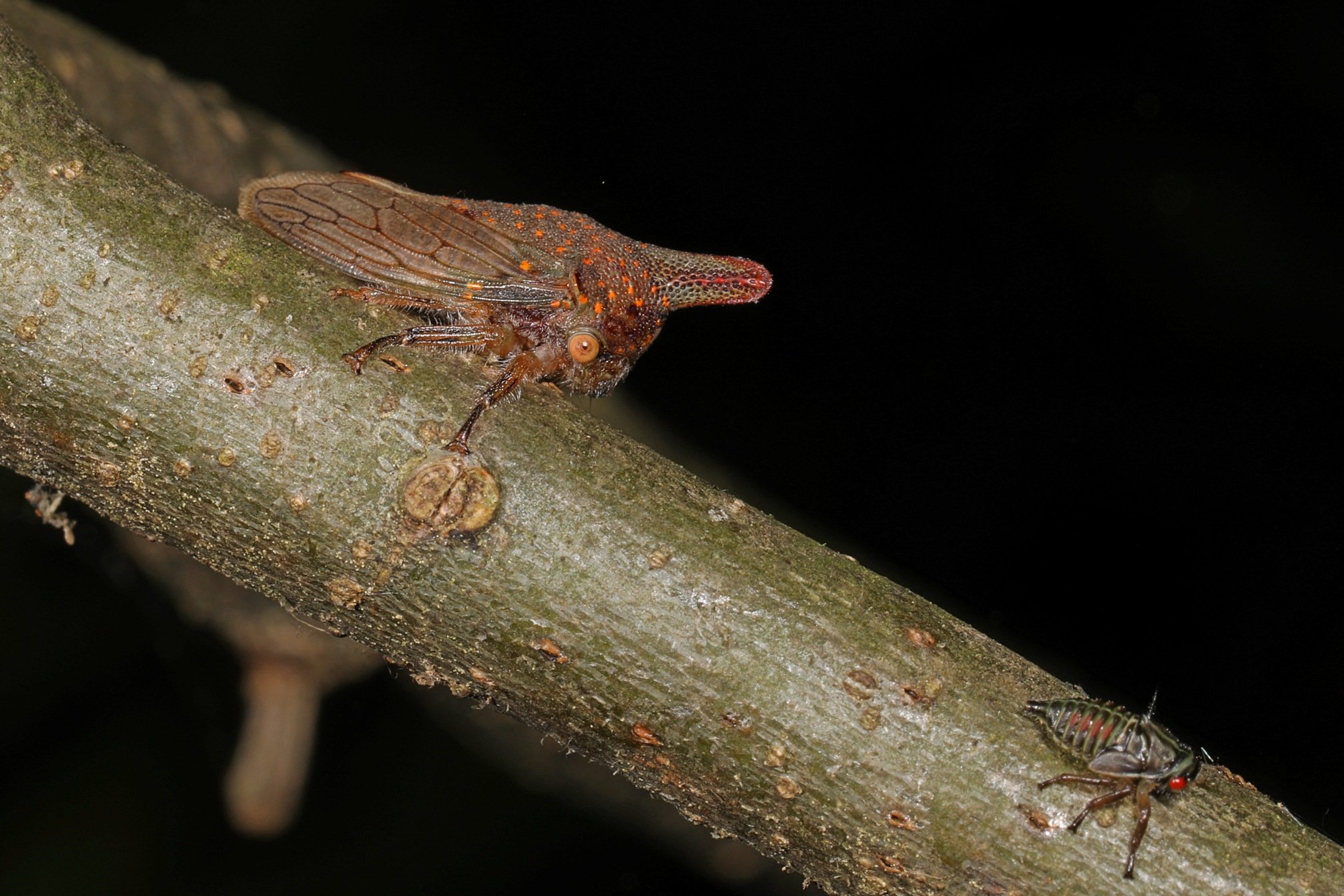Photo: Oak Treehopper, Platycotis vittata, Judy Gallagher
Judy Gallagher is an ASNV board member and a regular surveyor of local wildlife who also captures photos of what she sees, in particular the less common species.
One thing I really like about macro insect photography is how much is revealed when the insect is illuminated and expanded. A small dark spot becomes a colorful object with intricate patterns.
Oak Treehopper, Platycotis vittata, Judy Gallagher
This is particularly true for Treehoppers, true bugs (order Hemiptera) most closely related to Cicadas and Leafhoppers. Treehoppers are small, usually less than 1/2 inch long. They have short, bristle-like antennae, three-segmented feet, and a large thorax shield called a pronotum that extends backward to cover the abdomen, and sometimes also covers the head.
Poppea species, Mindo, Ecuador, with ant-shaped pronotum , Judy Gallagher
The pronotum can be humped or pointed to resemble a thorn, or have other unusual shapes. One that I saw a few years ago in Ecuador has a pronotum that resembles an ant. This presumably acts as a protection against predation because most predators don't want to deal with an angry ant. Recent studies suggest that the pronotum relies on wing genes to grow, curious because the pronotum would not normally be associated with flight.
Treehoppers create vibrational songs transmitted through their host plants. These songs communicate alarm, discovery, and courtship signals. They also can indicate that a treehopper has found a good place to feed, and the signal will attract others to that location. Each species has unique vibrational signals.
Treehoppers move around in a couple of ways. As the hopper name implies, they can hop from one location to another using their powerful hind legs. Studies suggest that the wings alone aren't sufficient to make the treehopper airborne, so they can also use the hop to propel them into flight.
Keeled Treehopper, Entylia carinata, mother protecting her eggs, Judy Gallagher
Treehoppers don't undergo complete metamorphosis. They have three life stages: egg, nymph and adult. Many treehopper species insert their eggs into the twigs of trees. This can damage the plant, but usually not badly. Adults of some species protect their eggs.
Oak Treehopper, Platycotis vittate, adult with nymph, Judy Gallagher
And some adults protect their nymph children as well, by waving their front limbs at or kicking at an attacker with their hind legs.
Ceresini tribe Treehopper nymph, Judy Gallagher
Nymphs shed their external skeleton several times before developing wing pads and turning into adults. The nymphs resemble what they will look like as adults, but without wings, and often with bristly hairs as seen above.
There are at least 260 species of treehoppers in North America. Some species feed on several different plants, but many treehoppers are found on a single host plant or family. Some plants, like the Black Locust, host more than one treehopper species. And although they usually feed on trees, some feed on non-woody plants. Treehopper mouthparts have two tubes. One injects saliva, which keeps the plant from closing up the hole, and the other tube sucks sap from the plant.
Ferruginous Carpenter Ant, Camponotus chromaiodes, and Black Locust Treehoppers, Vanduzea arquata, Judy Gallagher
Many treehopper species have a symbiotic relationship with ants. The ants stroke the treehoppers to get them to produce amino acid and carbohydrate-rich excretions which the ants drink, and in return, the ants protect the treehoppers from predators. Treehoppers are a food source for birds and larger insects, and so need protection.
Thornbug, Umbonia crassicornis, in Everglades National Park, Judy Gallagher
I mentioned previously that most treehoppers don't cause much damage to their host plant. One exception is the Thornbug, found only in frost-free areas like south Florida. The problem with them is that there can be so many individuals that they effectively defoliate a plant. They are colorful, and like many colorful insects, are distasteful to predators. Despite their color, they are hard to spot. The only reason I saw these was that I couldn't believe there were that many thorns on a branch, and so took a closer look.
View more of Judy’s Observations from Meadowood articles here.







